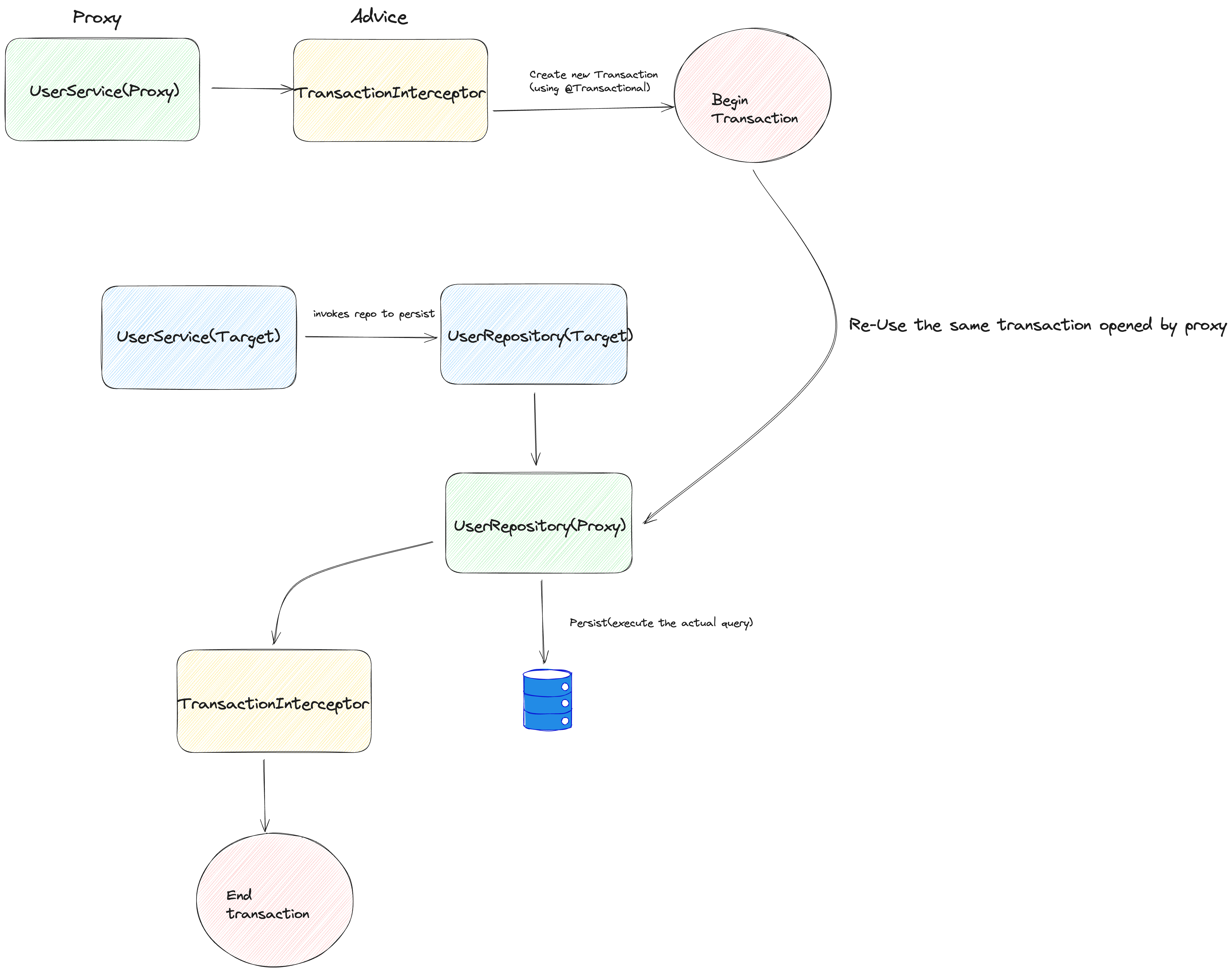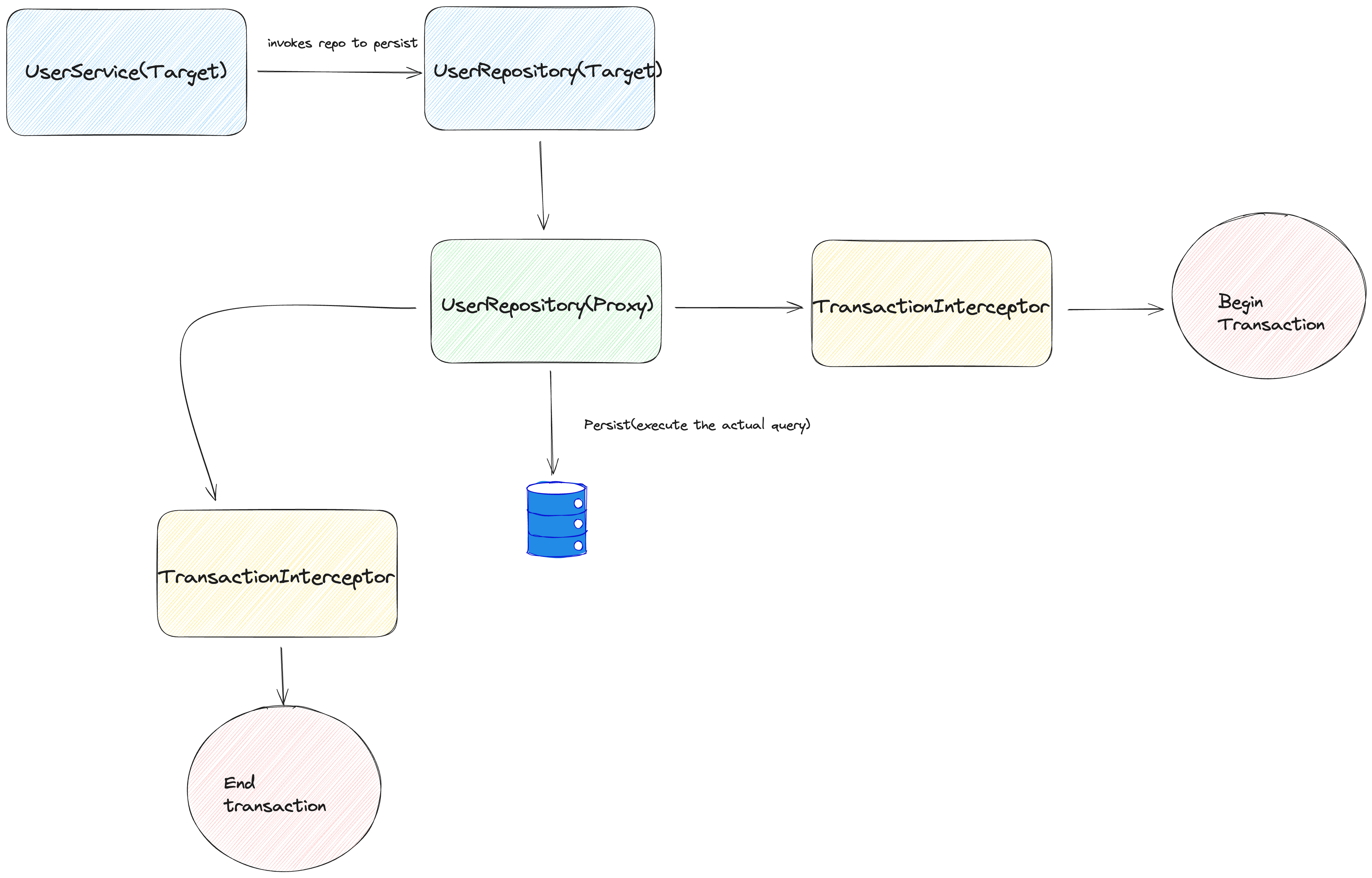Dissecting Springs @Transactional Annotation
Table of Contents
In Spring we widely use @Transactional annotation for executing bunch of stuff wrapped up in a DB transaction. Spring makes it easier for us to leverage AOP(Aspect Oriented programming) and does not pollute our business logic with DB Transaction, security, caching, logging etc. Before diving into the nitty-gritties of @Transactional, lets start with what are proxy objects and how does Spring makes use of it for @Transactional
What is a proxy and how does Spring uses it under the hood?
Proxy acts like a substitute for the given object. It acts as a middleman and when any client calls a method on an object, proxy object appears and acts on behalf of that object and performs any kind of action before/after method invocation.
In other programming lanuages like golang(we have hooks in GORM - https://gorm.io/docs/hooks.html) which behaves or act in a similar way. Below is a simple example.
Lets say I have a Service interface which is implemented by a DummyService. DummyService simply just does a simple work and logs Work is in progress. What if there are actions I want to take before doing a work and after doing a work which does not have any relation with the actual work or the business logic??.
public interface Service {
void doWork();
}
public class DummyService implements Service {
@Override
public void doWork() {
System.out.println("Work is in progress");
}
}
Here comes the proxy for the rescue which helps in performing the before and after work.
public static void main(String[] args) {
// 1. Create a dummy Service
Service realDummyService = new DummyService();
// 2. create a proxy and wrap the business logic/method invocation inside it.
// Here before invoking the actual business logic we perform the before work
// and after method invocation, perform the after work
Service proxyDummyService = (Service) Proxy.newProxyInstance(
realDummyService.getClass().getClassLoader(),
new Class[]{Service.class},
(Object proxyObj, Method method, Object[] methodArgs) -> {
// Wrapping up the business logic inside proxy
System.out.println("Before " + method.getName());
Object result = method.invoke(realDummyService, methodArgs);
System.out.println("After " + method.getName());
return result;
}
);
// 3. invoke the method via proxy and not the actual object
proxyDummyService.doWork();
}
Below is the output of how proxy works
Before doWork
Work is in progress
After doWork
How does Springs @Transactional Works ?
Springs @Transactional simply creates a database transaction for bunch of stuff inside the method annotated with it. @Transactional uses proxy objects to wrap up the business logic inside transactions.
Lets consider an example to understand.We have UserService which in turn uses UserRepository to persist.
// UserService.java
import org.springframework.stereotype.Service;
import org.springframework.transaction.annotation.Transactional;
@Service
public class UserService {
private final UserRepository userRepository;
public UserService(UserRepository userRepository) {
this.userRepository = userRepository;
}
public void doSomething(String name, String email) {
createUser(name, email);
}
@Transactional
public void createUser(String name, String email) {
User user = new User(name, email);
System.out.println("Transaction active? " +
org.springframework.transaction.support.TransactionSynchronizationManager.isActualTransactionActive());
this.userRepository.save(user);
}
}
// UserRepository.java
import org.springframework.data.jpa.repository.JpaRepository;
public interface UserRepository extends JpaRepository<User, Integer> {
}
When createUser is invoked(Directing invoking method annotated with @Transactional)
When createUser is invoked directly, proxy object which was created for UserService is used and wraps the actual business logic with TransactionInterceptor (an advice which gets invoked by proxy and starts the transaction).

When doSomething is invoked(Indirect invoking method annotated with @Transactional within same bean)
When doSomething is invoked, proxy does not get involved here as we invoke createUser it gets invoked from the same class and target object uses this to invoke createUser. In this case proxy object of UserService does not wrap the business logic with TransactionInterceptor and it does not start a transaction.
public void doSomething(String name, String email) {
createUser(name, email);
}
Here only UserRepository proxy object which was created is used and wraps the actual business logic(save) with TransactionInterceptor (an advice which gets invoked by proxy and starts the transaction).
